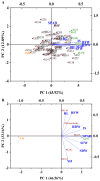Comprehensive Physio-Biochemical Evaluation Reveals Promising Genotypes and Mechanisms for Cadmium Tolerance in Tibetan Hull-Less Barley
- PMID: 39771291
- PMCID: PMC11676794
- DOI: 10.3390/plants13243593
Comprehensive Physio-Biochemical Evaluation Reveals Promising Genotypes and Mechanisms for Cadmium Tolerance in Tibetan Hull-Less Barley
Abstract
Cadmium (Cd) toxicity in agricultural soil is increasing globally and significantly impacts crop production and food safety. Tibetan hull-less barley (Hordeum vulgare L. var. nudum), an important staple food and economic crop, exhibits high genetic diversity and is uniquely adapted to the harsh conditions of the Qinghai-Tibet Plateau. This study utilized hydroponic experiments to evaluate the genotypic differences in Cd tolerance among 71 Tibetan hull-less barley genotypes. Physiological assessments revealed significant reductions in various growth parameters under Cd stress compared to normal conditions: soil-plant analysis development (SPAD) value, shoot height, root length, shoot and root fresh weight, shoot and root dry weight, of 11.74%, 39.69%, 48.09%, 52.88%, 58.39%, 40.59%, and 40.52%, respectively. Principal component analysis (PCA) revealed key traits contributing to Cd stress responses, explaining 76.81% and 46.56% of the variance in the preliminary and secondary selection. The genotypes exhibited varying degrees of Cd tolerance, with X178, X192, X215, X140, and X162 showing high tolerance, while X38 was the most sensitive based on the integrated score and PCA results. Validation experiments confirmed X178 as the most tolerant genotype and X38 as the most sensitive, with observed variations in morphological, physiological, and biochemical parameters, as well as mineral nutrient responses to Cd stress. Cd-tolerant genotypes exhibited higher chlorophyll content, net photosynthesis rates, and effective photochemical capacity of photosystem II, along with an increased Cd translocation rate and reduced oxidative stress. This was accompanied by elevated activities of antioxidant enzymes, including superoxide dismutase (SOD), peroxidase (POD), and catalase (CAT), indicating a robust stress response mechanism. These findings could facilitate the development of high-tolerance cultivars, with X178 as a promising candidate for further research and cultivation in Cd-contaminated soils.
Keywords: antioxidant enzyme; cadmium tolerance; hull-less barley; integrated score; oxidative stress; photosynthesis.
Conflict of interest statement
The authors declare no conflicts of interest.
Figures









Similar articles
-
Comparative transcriptome analysis reveals key long noncoding RNAs for cadmium tolerance in Tibetan hull-less barley.Front Plant Sci. 2025 May 22;16:1572490. doi: 10.3389/fpls.2025.1572490. eCollection 2025. Front Plant Sci. 2025. PMID: 40475905 Free PMC article.
-
Antioxidant defense system and cadmium uptake in barley genotypes differing in cadmium tolerance.J Trace Elem Med Biol. 2006;20(3):181-9. doi: 10.1016/j.jtemb.2005.12.004. Epub 2006 Jun 2. J Trace Elem Med Biol. 2006. PMID: 16959595
-
Exogenous Glycinebetaine Reduces Cadmium Uptake and Mitigates Cadmium Toxicity in Two Tobacco Genotypes Differing in Cadmium Tolerance.Int J Mol Sci. 2019 Mar 31;20(7):1612. doi: 10.3390/ijms20071612. Int J Mol Sci. 2019. PMID: 30935160 Free PMC article.
-
Comparative proteomics analysis of Tibetan hull-less barley under osmotic stress via data-independent acquisition mass spectrometry.Gigascience. 2020 Mar 1;9(3):giaa019. doi: 10.1093/gigascience/giaa019. Gigascience. 2020. PMID: 32126136 Free PMC article.
-
Modulation of exogenous glutathione in antioxidant defense system against Cd stress in the two barley genotypes differing in Cd tolerance.Plant Physiol Biochem. 2010 Aug;48(8):663-72. doi: 10.1016/j.plaphy.2010.05.001. Epub 2010 May 11. Plant Physiol Biochem. 2010. PMID: 20605723
Cited by
-
Identification of Wheat Genotypes with High Tolerance to Combined Salt and Waterlogging Stresses Using Biochemical and Morpho-Physiological Insights at the Seedling Stage.Plants (Basel). 2025 Apr 22;14(9):1268. doi: 10.3390/plants14091268. Plants (Basel). 2025. PMID: 40364297 Free PMC article.
-
Comparative transcriptome analysis reveals key long noncoding RNAs for cadmium tolerance in Tibetan hull-less barley.Front Plant Sci. 2025 May 22;16:1572490. doi: 10.3389/fpls.2025.1572490. eCollection 2025. Front Plant Sci. 2025. PMID: 40475905 Free PMC article.
References
-
- Sikdar A., Jeyasundar P.G.S.A., Debnath B., Hossain M.S., Islam M.A., Ahammed G.J. Agrochemicals in Soil and Environment: Impacts and Remediation. Springer Nature; Singapore: 2022. Cadmium Contamination in the Soil Environment: Impact on Plant Growth and Human Health.
-
- Wu F., Zhang G., Dominy P. Four Barley Genotypes Respond Differently to Cadmium: Lipid Peroxidation and Activities of Antioxidant Capacity. Environ. Exp. Bot. 2003;50:67–78. doi: 10.1016/S0098-8472(02)00113-2. - DOI
-
- Wang N.H., Zhou X.Y., Shi S.H., Zhang S., Chen Z.H., Ali M.A., Ahmed I.M., Wang Y., Wu F. An MiR156-Regulated Nucleobase-Ascorbate Transporter 2 Confers Cadmium Tolerance via Enhanced Anti-Oxidative Capacity in Barley. J. Adv. Res. 2023;44:23–37. doi: 10.1016/j.jare.2022.04.001. - DOI - PMC - PubMed
-
- Ahmad P., Ahanger M.A., Alyemeni M.N., Wijaya L., Alam P. Exogenous Application of Nitric Oxide Modulates Osmolyte Metabolism, Antioxidants, Enzymes of Ascorbate-Glutathione Cycle and Promotes Growth under Cadmium Stress in Tomato. Protoplasma. 2018;255:79–93. doi: 10.1007/s00709-017-1132-x. - DOI - PubMed
Grants and funding
LinkOut - more resources
Full Text Sources
Miscellaneous

